#Lord John Beresford
Explore tagged Tumblr posts
Text
#OTD in Irish History | 22 November:
1773 – Lord John Beresford, Archbishop of Armagh and Primate of all Ireland, is born in Dublin. 1830 – Justin McCarthy, politician, novelist and historian, is born in Cork. 1869 – Jeremiah O’Donovan Rossa, Fenian, contests and wins a Tipperary by-election in abstentia, but is declared ineligible as a convicted felon. 1912 – Birth in Dublin of poet, dramatist and lawyer, Donagh MacDonagh, son of…

View On WordPress
#irelandinspires#irishhistory#OTD#22 November#Andrew Sullivan#Birmingham Six Charged#C.S. Lewis#Drummuckavall Ambush#England#History#History of Ireland#Hunger-Striker#IRA#Ireland#Irish History#Jeremiah O&039;Donovan Rossa#John F. Kennedy Assasination#Lord John Beresford#Margaret Thatcher#Máire Drumm#Sinn Fein
10 notes
·
View notes
Text
On November 8th 1820, Claire Clairmont wrote some satirical stories in her journal about Lord Byron and Percy Shelley—they were written as ideas for caricatures (the Regency era term for what we would now call editorial cartoons or comic strips):
Wednesday, November 8th.
Caricature for Albé. He, sitting writing poetry, the words “Oh! faithless Woman” round the room, hearts are strewed, inscribed, “We died for love of you.” Another—he catching a lady by her waist, his face turned towards her, his other hand extended holding a club stick in the act of giving a blow to a man who is escaping. From his mouth,
“The maid I love, the man I hate
I'll kiss her lips and break his Pate.”
Three more to be called Lord Byron's Morning, Noon and Night. The first: he looking at the sky, a sun brightly shining—saying: "Come, I feel quite bold and cheerful—there is no God.”
The second towards evening, a grey tint spread over the face of Nature, the sun behind a cloud—a shower of rain falling—a dinner table in the distance covered with a profusion of dishes, he (with a Wallup) says—“What a change I feel in me after dinner; where we see design we suppose a designer; I'll be a Deist—I am a Deist."
The third��evening—candles just lighted, all dark without the windows (a cup of green tea on the table): and trees agitated much by wind beating against the panes, also thunder and lightning. He says
"God bless me, suppose there should be a God—it is as well to stand in his good graces. I'll say my prayers to-night, and write to Murray to put in a touch concerning the blowing of the last Trump."
Pistols are on the table, also daggers—bullets—Turkish scymitars . . .
Another to be called “Lord Byron's receipt for writing pathetic History.” He sitting drinking spirits, playing with his white mustachios. His mistress, the Fornaria, opposite him drinking coffee. Fumes coming from her mouth, over which is written "garlich;" these, curling, direct themselves towards his English footman who is just then entering the room and he is knocked backward. Lord B. is writing, he says.
"Imprimis, to be a great pathetic poet. First prepare a small colony, then dispatch the Mother, by worrying and cruelty, to her grave; afterwards to neglect and ill-treat the children—to have as many and as dirty mistresses as can be found; from their embraces to catch horrible diseases, thus a tolerable quantity of discontent and remorse being prepared, give it vent on paper, and to remember particularly to rail against learned women. This is my infallible receipt by which I have made so much money."
The last his death. He dead extended on his bed, covered all but his breast, which many wigged doctors are cutting open to find out (as one may be saying) what was the extraordinary disease of which this great man died—His heart laid bare, they find an immense capital “I” grown on its surface—and which has begun to pierce the breast—They are all astonishment. One says, “a new disease.” Another. “I never had a case of this kind before.” A third what medicines would have been proper, the fourth holding up his finger (A desert island.)
Caricature for poor dear S. He looking very sweet and smiling. A little Jesus Christ playing about the room. He says:
“Then grasping a small knife and looking mild
I will quietly murder that little child.”
Another. Himself and God Almighty. He says:
"If you please God Almighty, I had rather be damned with Plato and Lord Bacon than go to Heaven with Paley and Malthus." God Almighty: “It shall be as you please, pray don't stand upon ceremony."
Shelley's three aversions: God Almighty, Lord Chancellor, and didactic Poetry . . .
Sources: The Journals of Claire Clairmont edited by Marion Kingston Stocking, Harvard, 1968, Archive.org. “The Lord Byron / John Polidori relationship and the foundation of the early nineteenth-century literary vampire” by Matthew Beresford, University of Hertfordshire June 2019. Byron: A Biography by Marchand, Vol. II, 1957.
#thus a tolerable quantity of discontent and remorse being prepared#literature#regency#regency era#claire clairmont#percy shelley#lord byron#journals#funny#history#writing#poets#writers#satire#geneva squad#the romantics#romantic age#romanticism#romantic poetry#romantic era
29 notes
·
View notes
Note
More question time, lol!
Other than James, is there any other hybrid dragons?
How do dragons react to lemon? (LOL)
What’s Emily’s origin?
Other than villain dragons and humans, are there anymore rivals or villains they face against like wolves?
Is Henry gentle to the forest animals and acts like a Father Nature type?
Is there any dragons that loves the beach or the coastal region?
OH MY GOSH. I'M ABOUT TO DROP SO MUCH LORE. THIS WAS MY EXACT REACTION WHILE MAKING THIS.👇 I AM UNHINGED. :D

Anyone reading this, you're gonna want to pull up a seat! This is gonna be long! Lol!
Other than James, is there any other hybrid dragons?: I would say yes. But they are very far and few between. At first. Let me explain a few things! So, in the golden days of dragons, there were many species. And they were all sorted into different classes. Titan, Standard, Dwarf, and Fey. (And there's Leviathan Class, but it's too big to show here.) In addition, they are subclasses like Seadragons, Serpents, Wyverns, Drakes, (Normal) Dragons, Fey Dragons, and Longs (Eastern Dragons). They sometimes also are sorted if they had any kind of magical abilities. And each of these would almost always mate only within their own species.

But then something happened. Humans got even smarter and started using tougher and more deadly weapons. Slowly dragon numbers began to dwindle and dragons began to migrate out of their usual habitats and into other species. These dragons started to find mates from other species in the areas they wandered to. Sometimes it was simply a matter of their species just dying out. Or the smaller territories crossing over. Either way, Hybrids were the results. They weren't super common at first. But by the time this AU's version of Journey Beyond Sodor comes around, they're WAY more common. In fact, Hurricane is a cross between a Titan Class (Gordon's Class) and a Standard Class (Thomas's Class)! EDIT: I forgot to mention! For this same reason, clans made up of multiple species also started to occur. Before, Dragon Clans were usually made up of only one species. But after families got separated and almost whole species killed off by humans, dragons began to bond with others outside their kind. Found family baby! :D
2. How do dragons react to lemon?: Weeeeeeeell...
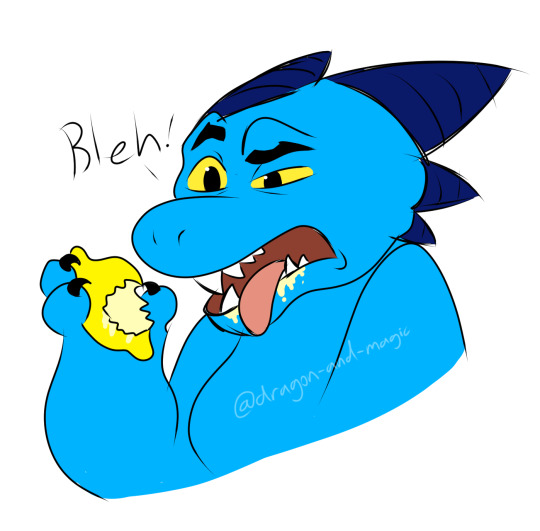
That's a definite NOPE from Thomas.🤣 Yeah, I don't like they would like them much. Lol!
3. What’s Emily’s origin?: Okay, so here's the thing. She is literally NESSIE. Aka The Loch Ness Monster!
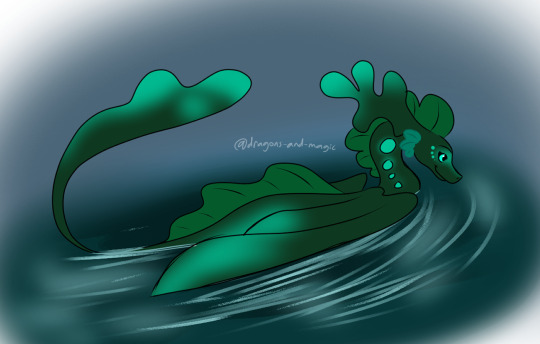
Well, she's what started the legend anyway. Albeit accidental. Lol. Here's the story. Emily is chilling in her Loch one day, minding her own business. She had just gotten up, so she isn't really paying attention to her surroundings. A camera flashes. Emily freezes and looks toward the shore. Two very nervous photographers are standing there. She panics and dives back down! But, she's a bit too late. Because, blurry as it is, that photo is enough to start a whole monster hunting craze. Suddenly the Loch is swimming with boats and flashing cameras, and Emily's whole clan has to relocate! And that's how she ended up on Sodor.😂
4. Other than villain dragons and humans, are there anymore rivals or villains they face against like wolves?: Do ghosts count? Sailor John is a pirate ghost in this story! But he disguises himself as a normal hooman. He has to find his old treasure chest, so he can become mortal again and rain terror across the seas again! Also, there's a few dangerous monsters and such. Trolls, Rock Monsters, Sand Worms, etc. (Beresford the crane is a bridge troll in this!) Sodor is actually part of an archipelago called The Golden Isles. So there's plenty of habitats for monsters to dwell. As for wolves, that's not such a bad idea! Perhaps something like Wargs could exist. They're the giant evil wolves from Lord Of The Rings. Something like that maybe.
5. Is Henry gentle to the forest animals and acts like a Father Nature type?: Absolutely! He loves the animals! And knows a lot about them! Because he's closer to animals than the others, he doesn't like to partake in hunting. And he has a more vegetarian diet.
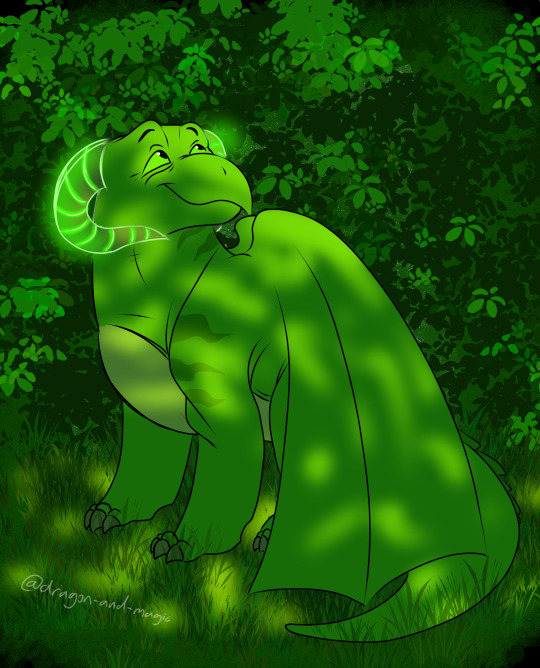
Of course, most dragons are predators, and need food to survive. And of course, if there was too many prey animals, the ecosystem would be unbalanced. So there has been a compromise made. Any animal located within fifty feet of Henry's den, (Located under the Wishing Tree!) is safe from hunting. Also, one more cool fact about him is he has plant magic! He can grow plants, and has something called Root Connection. He can basically telepathically sync up with the trees communication signals and find out what's going on anywhere in the forest! His horns and eyes get all glowy and everything!
6. Is there any dragons that loves the beach or the coastal region?: Definitely! There's three whole clans that live by the beach! Salty's clan is on the Southern Coast of the island. And you know Salty loves the ocean! His clan is made up of himself, Porter, Cranky, and eventually Big Mickey and Carly. Cranky is a big Leviathan Class Seadragon as you can see. Porter and Salty can ride him.
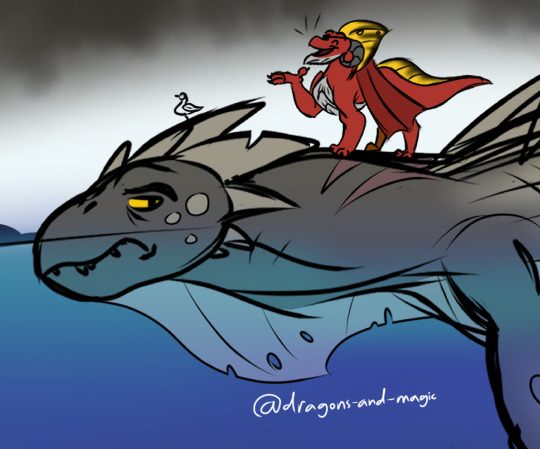
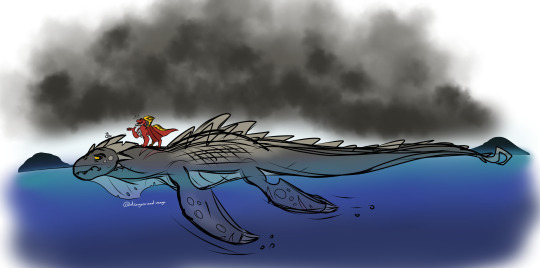
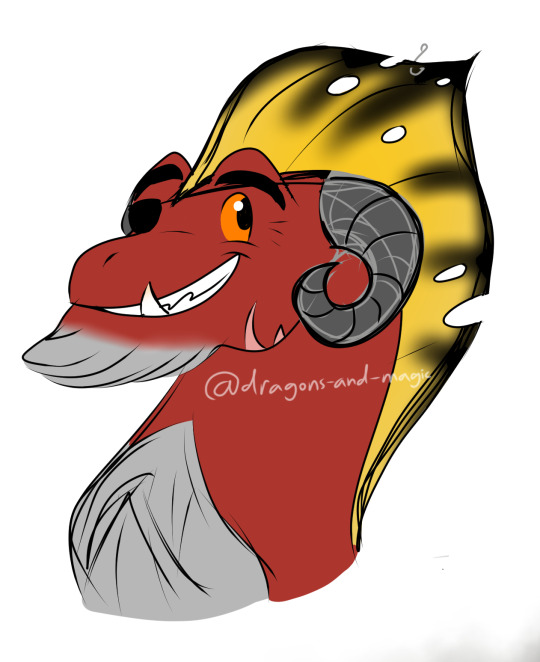
And then there's Belle's Clan! (This AU's version of the Sodor search and rescue team!) They live on the northern coast and watch out for incoming dragons and ships! They're like the watch men of the island! They live on a sea mount called The Roost! Her clan is made up of Flynn, Harold, Captain, Butch, and Rocky. Don't have designs for them yet. Sorry.😅 (Flynn x Belle is thing in this too!)
And then lastly, we have Duck's clan. And while they live more inland than the others, they are still located on the northern coast! Duck's clan has Donald, Douglas, Oliver, Skiff, Daisy, and Ryan!
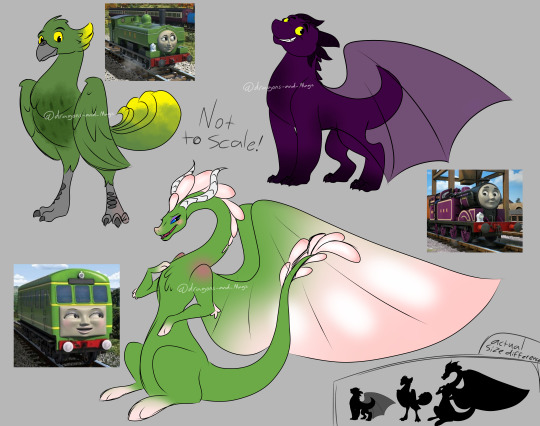
I don't have concepts for everyone yet. But here's Ryan, Daisy, and Duck's prototype designs! (Oh, and Ryan x Daisy is a thing in this!❤️)
And that's everything! For now.😉
Thanks for sending in so many questions! I had a ton of fun making this!
#ttte#ttte james#ttte thomas#ttte henry#Thomas and Friends#Asks#My art#Dragons of Sodor#ttte daisy#ttte duck#ttte ryan#fanart#ttte salty#ttte cranky#ttte porter#ttte belle#ttte flynn#ttte donald#ttte douglas#ttte oliver#ttte emily#Too many characters to tag!!!#Oh no!#Daisy x Ryan#Belle x Flynn#james ttte#thomas ttte#Emily ttte#thomas the tank engine#ttte DOS
19 notes
·
View notes
Text
50 Favorite Children’s Books
Inspired by Studio Ghibli director Hayao Miyazaki’s list of his earliest literary influences. This list is limited to books I read in childhood or youth. 50 Childhood Favorites
Caddie Woodlawn and sequel by Carol Ryrie Brink
Winter Cottage by Carol Ryrie Brink
The Saturdays, The Four-Story Mistake, and sequels by Elizabeth Enright
Enemy Brothers by Constance Savery
The Reb and the Redcoats by Constance Savery
Carry On, Mr. Bowditch by Jean Lee Latham
Derwood, Inc. by Jeri Massi
A Little Princess by Frances Hodgson Burnett
The Secret Garden by Frances Hodgson Burnett
Little House series by Laura Ingalls Wilder
Heidi by Joanna Spyri
Little Women by Louisa May Alcott
Understood Betsy by Dorothy Canfield Fisher
The Wheel on the School by Meindert De Jong
All-of-a-Kind Family by Sydney Taylor
Family Grandstand by Carol Ryrie Brink
Baby Island by Carol Ryrie Brink
Cheaper By the Dozen and sequel by Frank B. Gilbreth, Jr. and Ernestine Gilbreth Carey
Rebecca’s War by Ann Finlayson
The Lost Baron by Allen French
Snow Treasure by Marie McSwigan
Number the Stars by Lois Lowry
The Winged Watchman by Hilda Van Stockum
A Single Shard by Linda Sue Park
By the Great Horn Spoon by Sid Fleischman
Captive Treasure by Milly Howard
Toliver’s Secret by Esther Wood Brady
Silver for General Washington by Enid LaMonte Meadowcroft
Emil’s Pranks by Astrid Lindgren
Mrs. Frisby and the Rats of NIMH by Robert C. O’Brien
Hitty: Her First Hundred Years by Rachel Field
Twenty-One Balloons by William Pene du Bois
Freddy the Detective and Freddy the Pig series by Walter R. Brooks
The Cricket in Times Square by George Selden
Mr. Popper’s Penguins by Robert Lawson
Charlotte’s Web by E.B. White
The Borrowers by Mary Norton
The Wombles by Elisabeth Beresford
Homer Price by Robert McCloskey
The Westing Game by Ellen Raskin
Winnie-the-Pooh by A.A. Milne
Sir Cumference and the Dragon of Pi by Cindy Neuschwander and Wayne Geehan
Tuesdays at the Castle by Jessica Day George
The Bridge and Crown and Jewel by Jeri Massi
The Chronicles of Narnia by C.S. Lewis
The Gammage Cup by Carol Kendall
Ella Enchanted by Gail Carson Levine
The Hobbit by J.R.R. Tolkien
The Mysterious Benedict Society by Trenton Lee Stewart
The City of Ember by Jeanne DuPrau
Young Adult:
The Eagle of the Ninth and other books by Rosemary Sutcliff
The Bronze Bow by Elizabeth George Speare
The Lord of the Rings by J.R.R. Tolkien
Ranger’s Apprentice by John Flanagan
Dragon Slippers by Jessica Day George
Buffalo Brenda by Jill Pinkwater
The Arrival by Shaun Tan
Small Steps: The Year I Got Polio by Peg Kehret (a nonfiction memoir)
Picture Books:
Make Way for Ducklings and other books by Robert McCloskey
Go, Dog, Go by P.D. Eastman
Sam and the Firefly by P.D. Eastman
Robert the Rose Horse by Joan Heilbroner
Ice-Cream Larry by Daniel Pinkwater
Mr. Putter and Tabby by Cynthia Rylant
Discovered as an Adult: Seesaw Girl by Linda Sue Park
The Ordinary Princess by M.M. Kaye
The Armourer’s House by Rosemary Sutcliff
Urchin of the Riding Stars and the Mistmantle Chronicles by M.I. McAllister
Princess Academy by Shannon Hale
Johnny Tremain by Esther Forbes
Escape to West Berlin by Maurine F. Dahlberg
Listening for Lions by Gloria Whelan
The Angel on the Square by Gloria Whelan
Courage in Her Hands by Iris Noble
Knight’s Fee by Rosemary Sutcliff
Victory at Valmy (Thunder of Valmy) by Geoffrey Trease
Word to Caesar (Message to Hadrian) by Geoffrey Trease
The Letter for the King by Tonke Dragt
The Thief by Megan Whalen Turner
The Reluctant Godfather by Allison Tebo
Seventh City by Emily Hayse
Escape to Vindor by Emily Golus
Valiant by Sarah McGuire
The Secret Keepers by Trenton Lee Stewart
#children's books#children's classics#20th century classics#favorite books#books#reading#favorites#childhood#book recs#recommendations#book recommendations#influences#childhood influences
8 notes
·
View notes
Text
Birthdays 8.6
Beer Birthdays
Timothy Taylor (1826)
Dave Suurballe (1949)
Don Erickson (1961)
Mark Cowley (1964)
Marc Rosenblum (1972)
Paul Sangster
Five Favorite Birthdays
Piers Anthony; English writer (1934)
Paul Bartel; film director, writer, actor (1938)
Richard Hofstadter; historian, writer (1916)
Allan Holdsworth; English guitarist (1946)
Robert Mitchum; actor (1917)
Famous Birthdays
Alfred, Lord Tennyson; English writer, poet (1809)
Lucille Ball; actor (1911)
Paul Bartel; actor, director, & screenwriter (1938)
Elisabeth Beresford; English journalist & author (1926)
Peter Bonerz; actor (1938)
Asia Carrera; porn actor (1973)
Paul Claudel; French writer (1868)
Jess Collins; artist (1923)
Barbara Cooney; author and illustrator (1917)
Kimberly Conrad; Playmate of the Year 1989 (1962)
Randy DeBarge; singer-songwriter & bassist (1958)
Vera Farmiga; actress (1973)
Alexander Fleming; bacteriologist (1881)
Charles Fort; author (1874)
Soleil Moon Frye; actress (1976)
Melissa George; actress (1976)
Hoot Gibson; actor (1892)
John Graves; author (1920)
Geri Halliwell; pop singer (1972)
Catherine Hicks; actress (1951)
Byard Lancaster; saxophonist and flutist (1942)
Richard C. Miller; photographer (1912)
Marisa Miller; model (1978)
Scott Nearing; sociologist, natural-food advocate (1883)
Leslie Odom Jr.; actor and singer (1981)
Jason O'Mar;, Irish actor (1972)
John Middleton Murry; English poet and author (1889)
Jon Postel; computer scientist (1943)
JonBenét Ramsey; child beauty queen & murder victim (1990)
Dutch Schultz; gangster (1901)
M. Night Shyamalan; film director (1970)
Elliott Smith; singer-songwriter and guitarist (1969)
Andy Warhol; artist (1928)
Norman Wexler; screenwriter (1926)
Michelle Yeoh; actress (1962)
1 note
·
View note
Text
REBELLION RISING ON THE RISE: 2009-2018
THE FRANCE AND IRISH LINK TO THE REBELLION:
THE PARANORMAL HOTSPOT IN ROUSE HILL REGIONAL PARK
THE REAL CENTER OF THE CIVIL WAR OF THE REBELLION OF VINEGAR HILL PART 1:

My hypothesis is there is a link to the slave revolts in Haiti and the Battle of Vinegar ill where the Irish slaves attempted to overthrow their English captors.
This is founded by my initiation into haitian voodoo, 21 divisions creole spiritism which combines with my cereominal magician tradition starting HARDCORE at the same site (the battle site of vinegar hill) back in 2009.
All events were extreme paranormal and unexplained anomalous events, experienced by a friend and I who were yet to be formally initiated into ceremonial magick or vodou.
A magical portal was opened which took me until 2018 to close
many ufo and other supernatural events took place at this site
which can be ascribed to the closest site to the only civil war in Australia has ever witnessed.

My notes on the historical context from 2022
1789
After 1789, some Volunteer units showed their sympathy with the French Revolution by holding parades on 14 July to commemorate the fall of the Bastille. In 1792, Grattan succeeded in carrying an Act conferring the franchise on the Roman Catholics; in 1794, he introduced a reform bill that was even less democratic than Flood’s bill of 1783.
He was as anxious as Flood had been to retain the legislative power in the hands of men of property, for he had a strong conviction that while Ireland could best be governed by Irish hands, democracy in Ireland would inevitably turn to plunder and anarchy. The defeat of Grattan’s mild proposals helped to promote more extreme opinions. However, as soon as the Jacobin regime assumed power in France, radical Patriots became more reluctant to refer to France as a prime example of Catholic political action for the causes of liberty and justice. Nevertheless, one of the main inconsistencies on the Patriot political agenda by calling for increasing powers of the Irish parliament while maintaining the selective as opposed to universal suffrage seemed to have been dissolved.
However, the French Revolution also had a second, contrasting, effect. Conservative loyalists such as John Foster, John Fitzgibbon and John Beresford, however, remained opposed to further concessions to Catholics and, led by the ‘Junta’, argued that the ‘Protestant Interest’ could only be secured by maintaining the connection with Britain. In reactionary circles, it was used to emphasise the point that an open political debate without censorship as well as parliamentary reform could entail a severe blow to their special interests, and could be tantamount to inviting Radicals to overturn the political structure of the country, rather than just appeasing them. In particular, the French Revolution prompted relentless action against the radical wing of the Patriot movement, the United Irishmen that included many former Whigs. It also prevented more moderate Patriots from supporting some radical Patriot activities without reservation, depriving the Patriot movement of solidarity and unity.
1688-91
WILLIAMITE WAR
William of Orange - dutch born
William of Orange, the Dutch prince who became King of England, Scotland, and Ireland in the Glorious Revolution of 1688
Defeated catholic "james 2nd" in wiliamite-jacobite war.
Protestant ascendancy
THE DECLATORY ACT OF 1719
Loss of Independence due to the House of British Lords being able to pass laws in Ireland
Restrictions of commerce at the expense of ireland that favoured Britain were tipping this rise to the protestant ascendancy for GREATER freedoms from great britain.
ORANGE ORDER:
The basis of the modern Orange Order is the promotion and propagation of "biblical Protestantism" and the principles of the Reformation. As such the Order only accepts those who confess a belief in a Protestant religion.
As well as Catholics, non-creedal and non-Trinitarian Christians are also banned.
This includes members of The Church of Jesus Christ of Latter-day Saints(Mormons), Jehovah's Witnesses, Unitarians, and some branches of Quakers.
Previous rules specifically forbade Roman Catholics and their close relatives from joining
but the current rules use the wording "non-reformed faith" instead. Converts to Protestantism can join by appealing to Grand Lodge.
James Wilson and James Sloan, who issued the warrants for the first Lodges of the Orange Order along with 'Diamond' Dan Winter, were Freemasons,[26] and in the 19th century many Irish Republicans regarded the Orange Order as a front groupestablished by Unionist Masons as a more violent and jingoist vehicle for the promotion of Unionism.[71] Some anti-Masonic evangelical Christian groups have claimed that the Orange Order is still influenced by freemasonry.[72] Many Masonic traditions survive, such as the organisation of the Order into lodges. The Order has a similar system of degrees through which new members advance. These degrees are interactive plays with references to the Bible. There is particular concern over the ritualism of higher degrees such as the Royal Arch Purple and the Royal Black Institutions
1795: the battle of richmond hill
Darug natives defend the land from british invaders
North richmond - pitt town wetlands.
1798
The first battle of vinegar hill
County wicklow
The catholics invasion and claim to the irish land and protestant ascendancy
Act of union 1800- rise to catholic invasion that allowed the mobilisation of the catholic poplation
Uniteed the british parliament and irish parliement in unity, to form a united front
Catholic resentment in leinster
1789
THE AFRO-CARIBBEAN LINK
UNITED IRISH PRISONER
JAMAICA
WEST INDIES
NEW FOUNDLAND
NEW SOUTH WALES
"United Irish" mutinies in Jamaica, Newfoundland and New South Wales
In October 1799 Castlereagh received reports from Jamaica that many (of the 3,200)
United Irish prisoners, "incautiously drafted" into regiments for service in the West Indies, had taken to the hills to fight alongside the Maroons and with the French: "as soon as they got arms into their hands they deserted".
There is no suggestion that this was part of any trans-Atlantic design of the United directory in Dublin or Paris.
The same is true of the "United Irish Uprising in Newfoundland" in April 1800. Two-thirds of the colony's main settlement, St. John's, were Irish, as were most of the island's locally-recruited British garrison. There were reports that upwards of 400 men had taken a United Irish oath, and that eighty were resolved to kill their officers and seize their Protestant governors at Sunday service. As in Jamaica, the mutiny (for which 8 were hanged) may have been less a United Irish plot, than an act of desperation in the face of brutal living conditions and officer tyranny.
Yet the Newfoundland Irish would have been aware of the agitation in the homeland for civil equality and political rights.
There were reports of communication with United men in Ireland from before '98 rebellion;of Thomas Paine's pamphlets circulating in St John's;and, despite the war with France, of hundreds of young Waterford men still making a seasonal migration to the island fisheries, among them defeated rebels who are said to have "added fuel to the fire" of local grievance.
In March 1804, stirred by news of Emmet's rising, several hundred United Irish convicts in New South Wales tried to seize control of the penal colony and to capture ships for a return to Ireland.[204] Poorly armed, and with their leader Philip Cunningham seized under a flag of truce,the main body of insurgents were routed in an encounter loyalists celebrated as the Second Battle of Vinegar Hill.
The 1803 Michael Dwyer, who was a captain of the irish rebellion of 1798, transported to NEW SOUTH WALES
-1807 x 2 imprisoned and x2 trials for plotting against the british penal rule in NSW
1804
The second battle of vinegar hill
LIBERTY OR DEATH!
‘Death or Liberty’
The 1804 Castle Hill convict rebellion was led by Philip Cunningham of Moyvane, north County Kerry, a government stonemason who was convicted for his involvement in the 1798 Irish rebellion; he was also involved in a mutiny on board the convict transport ship, the Anne.
He was key figure in the planning of the rebellion, along with his rebel assistants William Johnston and Samuel Humes.[
Accompanied by over 200 frustrated armed Irish convicts, their aim was to capture ships and sail to Ireland. The rebels gathered at Castle Hill, calling on other convicts to join them.
Their intention was to march from Windsor to Parramatta, and then onto Sydney, gathering recruits along the way to attain a ship to bring them back to Ireland.
The Irish rebels were betrayed by an informer Keogh, who told the authorities of the Irish convicts’ plans.
By 1804, most of the Irish leaders of the previous attempts at rebellion had been imprisoned and moved to outlying areas of the colony such as Norfolk Island. Dispersal had worked well for the authorities but with each new rebellion plan, new Irish leaders rose among the convicts more aware of what not to do next time. The leaders of rebellion on 4 March 1804 were Phillip Cunningham and William Johnston.
Cunningham was a veteran of the 1798 conflict in Ireland and the mutiny of the convict transport ship Anne. From his experiences in Ireland and NSW he understood that secrecy and a non-traceable but effective communication were essential to a successful rebellion.
Cunningham’s emphasis on secrecy was so successful that it was not until the day before the rebellion that the authorities knew of its existence.
On the evening of 3 March, one of the Irish convict overseers turned informant. On Sunday 4 March, the day of the rebellion, two more informants came forward and provided names.
John Griffen was one of the informants and had been relaying a message to the pike-maker Bryan Furey that the rebellion was on for Sunday night.
Since Furey did not get the message the areas of Sydney, Parramatta and Windsor did not rebel.
Castle Hill was the only district that rose in rebellion.
Despite this intelligence, the authorities in Parramatta and Sydney did not act immediately and on 4 March 1804, John Cavenah set fire to his hut in Castle Hill at 8.00 pm. This was the signal for the rebellion to begin.
With Cunningham leading, 200 rebels broke into the Government Farm’s buildings, taking firearms, ammunition and other weapons. Initially, there was mayhem as buildings were ransacked to cries of ‘Death or Liberty’. Two English convicts dragged the Hills District flogger, Robert Duggan from under his bed and George Harrington an English convict beat him unconscious. A constable was saved from a musket ball in the face when the musket of John Brannon misfired.
Another constable was saved in similar circumstances when Jonathon Place’s musket also misfired. Cunningham gathered the rebels and reprimanded them for their lack of disciplined behaviour.
The rebels then went from farm to farm on their way to Constitution Hill at Parramatta gathering firearms, supplies and drinking any liquor they found. The looting of farms gave the rebels over 180 swords, muskets and pistols. In 1804, this was close to one third of the colony’s entire armoury
I do therefore proclaim the Districts of Parramatta, Castle Hill, Toongabbie, Prospect, Seven and Baulkham Hills, Hawkesbury and Nepean to be in a STATE of REBELLION; and to establish Martial Law throughout those Districts…
Cunningham’s plan involved burning the MacArthur property of ‘Elizabeth Farm’ in order to draw the Parramatta garrison out of the town.
Once this was done the rebels in Parramatta would rise up and set fire to the town as a signal. The Castle Hill rebels would gather at Constitution Hill and then raid the barracks for more arms and ammunition.
From there the rebels would march to Windsor and join up with the rebels in the Hawkesbury before marching on Sydney. At dawn on 5 March, rebels were still straggling in to Constitution Hill. Phillip Cunningham and William Johnston were busy drilling the rebels on the hill while they were waiting for the signal from the uprising rebels in Parramatta. The signal never came. Cunningham’s messages to the Parramatta and Windsor rebels had not got through. Cunningham decided that the rebels would head down the Hawkesbury Road to Windsor to meet up with the rebels from the Hawkesbury. Had Cunningham effected this, King maintained it would have increased his force by a further hundred rebels.[10]
Colonial paranoia increased once evidence of planned rebellion became evident after 1800 but how real was the threat from Irish convicts?
The Defenders and United Irishmen transported between 1795 and 1806 provided leadership to those convicts, many Irish but including English transportees, who were prepared to take direct action to overthrow the colonial authorities.
Although it was the Irish convicts who were a particular concern to Hunter, King and Bligh, it is important not to over-exaggerate their significance while under-estimating the involvement of convicts of other nationalities. In addition, the Irish convict leadership had considerable experience in planning and implementing rebellious activities.
This explains why successive governors sent leaders or presumed leaders, whether there was concrete evidence of sedition or not, to the more isolated penal settlements on Norfolk Island and VDL. This had the effect of disrupting any planning for insurrection.
Finally, hatred of the British in Ireland was transposed to NSW and this meant that Irish leaders had a willing supply of convicts who were prepared to support their actions.
That support came from non-Irish convicts is a reflection of the punitive and arbitrary nature of convict life. Where they were concentrated in one area, as on the Castle Hill farm, Ireland’s cause helped bind these men together.
However, there were major problems for those seeking rebellion. First, keeping planning secret was a major difficulty and only the Castle Hill revolt in 1804 saw planning converted into action.
Convicts were always willing to ‘split upon each other’ and this allowed the authorities to intervene before matters spiralled out of control.
Secondly, the objectives of rebellion such as the rallying cry of ‘Death or Liberty’ or demands for a ship to go home were idealistic and unrealistic. Although these may have been the aims of rebel leaders, there is little evidence that they were widely held by the rank-and-file, many of whom claimed that they had been forced into rebellion
Thirdly, as in Ireland during the 1798 rebellion, when faced with even inferior military force, the rebels could not translate numerical strength into military victory.
Finally, the hoped for French aid was illusory as it was never part of French strategy and, during the critical period from 1801 to 1804 war in Europe had been suspended.
It was the British government that was constantly afraid of convict rebellion and disorder though this did not stop it from sending political prisoners to NSW despite the concerns of successive governors. For the authorities, a colony composed largely of convicts was inevitably turbulent and rebellious, something reflected in Hunter’s and King’s despatches. In his reports on NSW and VDL, Bigge considered that the best security against rebellion was the higher standard of living that convicts generally enjoyed in NSW than in Britain and the opportunities and rewards open to those with industry and skill. Some convicts ‘bolted’ but only a few rebelled.
Rouse Hill Estate
Vinegar Hill was not a formal location in 1804.
The battle between the rebels and the soldiers became commonly known as the ‘Battle of Vinegar Hill’ after the Irish battle in 1798. Common usage of the name Vinegar Hill began to appear in the 1810s and 1830s in the Rouse Hill area.
But there is no formal Vinegar Hill on a map. There have been competing thoughts for the location of Vinegar Hill.
Originally it was thought to be Rouse Hill, George Mackanass challenged this in the 1950s marking the location of Vinegar Hill as the crossroads between Windsor Road and Schofields Road.
THIS WAS THE LOCATION OF ROUSE HILL REGIONAL PARK, in which my friend and I partook in rituals with an optical crystal ball resulting in FULL BLOWN MANIFESTATIONS.
-1816
Richard rouse
Built tollhouses, turnpikes, estates from Parramatta to Liverpool
On 8 October 1816 Rouse was granted 180 hectares (450 acres) near the site of the Castle Hill convict rebellion; at the suggestion of Macquarie the grant was named Rouse Hill. The actual possession of the land had taken place a few years previously, as the Sydney Gazette had first mentioned Rouse Hill on 27 November 1813, and the homestead was begun soon afterwards. It took a few years to build and was a two-storey, twenty-two room house, which has been occupied by members of the Rouse family ever since.
Old government house & THOMAS MITCHELL ROYAL PEDIGREE ANCESTRAL ASSET
& THE HIDDEN HAND OF PARRAMATTA GOVERNMENT HOUSE AND THE TIMEKEEPERS SOUTHERN HEMISPHERE
this is an actual freemasonic ancestral connection of mine... this links to the rebellion and the colonisation of the country.
The Observatory, erected in 1822 was part of Brisbane's intention to make Parramatta "the Greenwich of the Southern Hemisphere" (DPWS 1997: p. 39).
1828, when Thomas Mitchell began the first trigonometrical survey of New South Wales, his initial meridian was taken from the Parramatta transit instrument in consultation with Dunlop. That survey underpinned mapping in New South Wales until recent times (Rosen 2003: p. 80).
Surveyor Edward Ebbsworth, when conducting his 1887 survey of Parramatta Park, ensured that the exact location of the piers would be preserved by fixing a copper plug in the basal stone of the piers.
Brisbane was accompanied to Australia by two astronomers: Charles Rumker, who had already attained a good reputation as an astronomer and mathematician; and James Dunlop, whose great natural ability in mechanical appliances and instruments saw him identified as a suitable man for second assistant in the Observatory in an out of the way place like Parramatta. On arrival in New South Wales, Brisbane's instruments were immediately set up on piers in the Domain to allow the observation of the solstice on 21 December 1821. B
April 1822, the construction of the observatory had been completed in anticipation of the appearance of Encke's Comet, an event not observable in Europe or at the Cape of Good Hope (Rosen 2003: p. 80).
The observatory was privately funded by Brisbane and consisted of two buildings: an observatory equipped at Brisbane's personal expense; and a residence attached to it. Located about 91 m (100 yards) behind Government House, the observatory was a plain building, 8.5 m (28 feet) square by 3.4 m (11 feet) high, with a flat roof with two domes 3.51 m (11 feet 6 inches) in diameter projecting from it, one at the north and the other at the south.
On the north and south sides were five windows, three of which were in a semi-circular projection from the wall at the base of the domes.
Transit openings in the domes extended to one of the windows to allow observations of the horizon. A 0.41-metre (16 in) Reichenbach repeating circle was located under the north dome and a 1.2-metre (46 in) equatorial Banks telescope was under the south dome.
There was also a Troughton mural circle and a 1.7-metre (5+1⁄2 ft) Troughton transit instrument. A Hardy clock showed sidereal time and a Brequet clock showed mean time.
All instruments were mounted on solid masonry piers.
There was also a Fortin pendulum and two instruments for observing the dip and variation of the magnetic needle.
CONVICT LIES
O’Farrell estimates about 1.5% of these were unambiguously sent out as political offenders or participants in rebellion or conspiracy, with the great bulk of these coming in the aftermath of the 1798 Rebellion.
If crimes of agrarian discontent and social disaffection are included under the heading of ‘political crimes’, then the proportion of Irish political transportees rises to about 20%. The great majority of Irish convicts were, therefore, sent to Australia largely for petty crimes.
Theory to link back to
JOHN DEE AND THE OPTICS OF THE CRYSTAL BALL USED BY THE MONARCHY OF BRITISH CROWN
BASED ON THE PROJECTION INTO THE ASTROLOGICAL, ASTRONOMICAL TRANSITS TO CONQUER VIA USING EDWARD KELLY AS "COURT MAGE" AND THE ENOCHIAN CHESS IN THE GLOBAL CONQUEST
real scrying methods take two or more people in the spiritual court for impact, as per 2009 - 2014 when K and I had adopted the original crystal ball between us resulting in full-blown manifestations, later confirmed by Kardec spiritism sources
my spirits advise me Australia is the prime spot for HAITI 2.0 FOR THE SECOND COMING OF THE SLAVE REVOLT IF THINGS CONTINUE THIS WAY ....
note the date and time and motions of movement
note the present economic, social and political happenstance
note the pestilence that has persistence against the masses who only want freedom and peace
note the objections from the overlords through clauses like agenda 2030, and sustainable development, which are just fancy names for the "new world order". which is just a modern 'human slave agenda" decked out in bureaucratic red tape.
freedom of choice, or be denied all liberty?
look at the manipulation that occurred as a result of COVID-19 and the forced COVID-19 vaccine agenda
when will the next thing that replicates occur, and when will humanity rise against the overlords to object in the most amicable and peaceful or diplomatic way, as clearly, the violence and bloodshed aren't going to work here.
PEACEFUL REBELLION.


#john dee#crystal ball#vinegar hill#1804#rebellion#the battle of vinegar hill#australian history#haunted australia#paranormal australia#parramatta#john dee and edward kelley#thomas mitchell#rouse hill regional park#supernatural australia#haunted places in australia#ley lines#the rum rebellion#haitian revolt#slave rebellion#irish rebellion#liberty or death#calling down the lwa.#rum rebellion#crystal balls#scrying#spiritism#haitian vodou#ogun#spirts#revolt
1 note
·
View note
Text

À medida que março chega ao fim, o início da temporada social se aproxima, transformando a poeira dos dias monótonos de inverno em sedas finas e passeios….

━ confira nossa STORILINE. ━ confira nossa TIMELINE HISTÓRICA. ━ confira nossa TIMELINE DE EVENTOS. ━ confira nossas RULE & EXPECTATIONS. ━ confira nossos SKELETONS. ━ conheça nossa SOCIETY. ━ para mais informações MOBNAV.

𝐀𝐃𝐌𝐈𝐍 𝐒𝐓𝐀𝐓𝐔𝐒 ⸻
ella [ online + offline + lurking]
𝐑𝐎𝐋𝐄𝐏𝐋𝐀𝐘 𝐒𝐓𝐀𝐓𝐔𝐒 ⸻ inscrições e interações abertas.
𝐂𝐇𝐀𝐏𝐓𝐄𝐑 ⸻ tba.
𝐋𝐀𝐓𝐄𝐒𝐓 𝐓𝐀𝐒𝐊 ⸻ journey to the past.
𝐋𝐀𝐓𝐄𝐒𝐓 𝐄𝐕𝐄𝐍𝐓 ⸻ tba
𝐑𝐄𝐒𝐄𝐑𝐕𝐀𝐓𝐈𝐎𝐍𝐒 𝐀𝐍𝐃 𝐀𝐏𝐏𝐋𝐈𝐂𝐀𝐓𝐈𝐎𝐍𝐒 ⸻ abaixo do corte. todas as reservas duram quarenta e oito horas e todos os horários estão em GMT.
reservations :
the Viscountess (até 28/03/2024 às 11h05);
applications :
Milly Alcock como Lady Adeline Maud Smythe-Smith, the Charmer (19);
Leyla Tanlar como Lady Aysun Byron, the Seer (22);
Jonah Hauer-King como Lorde Joseph Milles, the Fighter (27);
Jenna Coleman como Miss Henrietta Lockhart, the Tenderheart (27);
Anya Taylor-Joy como Lady Amarantha de La Fayette Beresford, the Coquette (25);
Fabien Frankel como Lorde Isaiah Seymour-Sharma, the Adventurer (27);
Santiago Cabrera como Lord Archibald Howard St. John, the Earl (34);
Enzo Vogrincic como Lorde Ulysses Hatherall, the Second Son (30);
Alisha Boe como Princesa Sophia Hanover, The Princess (22);

2 notes
·
View notes
Text
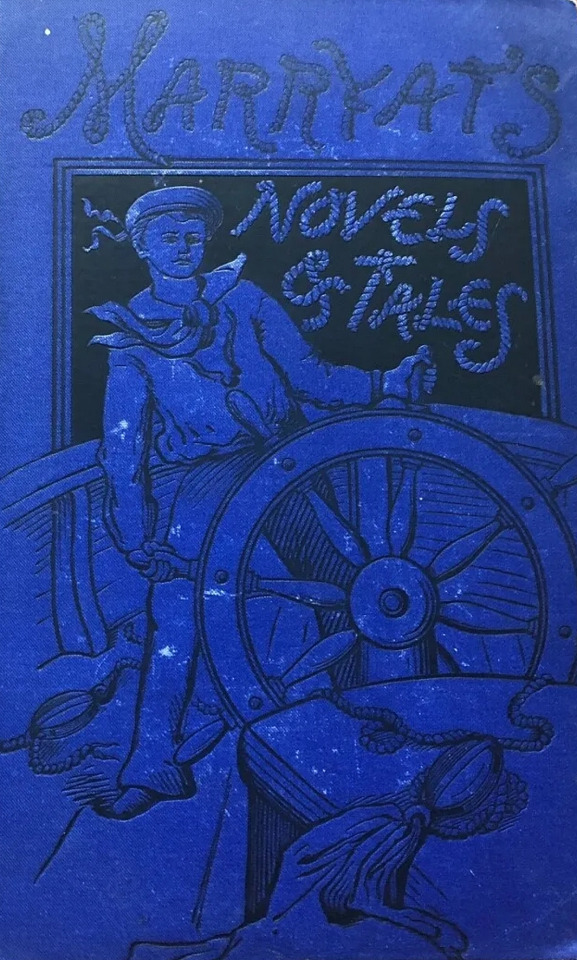
I have included Frederick Marryat, the most famous of naval novelists, not merely because he spent the first few years of his life afloat under Cochrane's command in the Impérieuse; but because the year 1829 saw the publication of his first novel, Frank Mildmay, and he was probably the best recruiting agent the Royal Navy ever had. His career, of which little seems to be known to the general public, was also full of incident.
— Captain Taprell Dorling, in the preface to his book Men o' War (1929), which contains short biographies of John Jervis (Earl of St. Vincent), Lord Thomas Cochrane, Frederick Marryat, John Fisher, and Lord Charles Beresford. The author's favourite Royal Navy men, in other words.
#frederick marryat#captain marryat#age of sail#royal navy#naval history#men o' war#biography#lord thomas cochrane#taprell dorling
27 notes
·
View notes
Text

I've got Captain Taprell "Taffrail" Dorling's 1929 book Men o' War open before me—a real Royal Navy officer's book of basically, his personal favourite Royal Navy officers that he fanboys over. And it's a short list of only five sea officers: John Jervis the Earl of St. Vincent, Lord Thomas Cochrane, Frederick Marryat, Jacky Fisher of Dreadnought battleship fame, and Lord Charles Beresford.
I'd say some questionable choices along with some very good ones, but Dorling has a type and it's Feisty Guy. The more sass and spirit in the guy, the better. So it's funny that he thinks Frank Mildmay is so awful, calling him "detestable" and also "a shameless, insolent, and cold-blooded young rascal of a decidedly vicious mode of life." —Buddy, he IS Frederick Marryat (but hotter, and he can sing, and a few other romantic embellishments). And Dorling even concedes that, allowing that he "may or may not have been" an autobiographical character.
Also for putting a lot of emphasis on all of the combat that Marryat experienced, Dorling doesn't seem to reflect on how much that violence and trauma manifests in his writing.
#someday i want to be in a position where i can unpack and analyse marryat to my heart's content#and have that stuff published and peer-reviewed#frederick marryat#royal navy#frank mildmay#taprell dorling#men o' war#also as much as marryat was bigoted and a jerk etc he had self-awareness to an interesting degree#shaun talks#naval history
13 notes
·
View notes
Photo

Mrs. William Beresford and her Son John, later Lord Decies, 1775, Joshua Reynolds
Medium: oil,canvas
22 notes
·
View notes
Text
The Terror of London: the story of Spring-Heeled Jack
Certainly Strange: A Podcast About The Unexplainable, episode 6
Listen on: YouTube Spotify Castbox
The Victorian era was a time of shadows and superstitions. In every corner of London’s dark streets lived a mystery or a monster. One of the most popular and certainly strange urban legends of this time is the story of the leaping devil, Spring-Heeled Jack.
In October, 1837, a young servant girl named Mary Stevens, is walking through Clapham Common to the house that she works at. Suddenly, a figure jumps from one of the shadows, gripping her tightly. The figure starts to kiss her face and tries to rip off her clothes. Mary cries out in alarm, and the figure vanishes. Of course, this just seems like a case where a man tried to molest the young woman. And it could have been exactly that, had the strange figure not ripped at Mary’s clothes with claws instead of hands. Claws, she said, that were “cold and clammy as those of a corpse.”
Mary Stevens was not the first one to see this strange clawed creature jump from the shadows. In September 1837, one month before the attack on Mary Stevens, a man saw a man with horns and red glowing eyes leap over the cemetery fence.
This strange devil-like man did not wait much longer to strike again after attacking Mary Stevens. The very next day, it was reported that a strange figure had jumped out in front of a traveling coach, causing the coachman to lose control and crash. Witnesses reported that the figure escaped by jumping over wall that was nearly 9 feet tall, whilst laughing uncontrollably.
This was also the very first time the police got involved. At the scene of the crime they found a pair of very deep tracks in the mud that could only have been made by jumping from a great height. The tracks also showed that there was some gadgetry on the shoes, and speculated that it might be “some sort of compressed springs”.
And this is how the strange devil-like figure got the name of Spring Heeled Jack.
It was January, 1838. Polly Adams, who worked as a barmaid, was walking across Blackheath in south London when she was suddenly attacked. She was discovered half-naked lying in the gutter. When she came to, she is reported saying that she had been attacked by a man who had ripped open her blouse and had grabbed her breasts with claws that were sharp and cold as a corpse, eventually cutting open her belly.
On January 9th, the Lord Mayor of London, Sir John Cowan, received an anonymous complaint of another servant girl who was attacked by Spring Heeled Jack. Because of this incident, several other people came forward about similar incidents in the Kensington and Hammersmith area, all involving servant girls.
This was the perfect story for the press, and Spring Heeled Jack began to get a lot of publicity. With the increase of publicity, there was also an increase of reports from people who had seen or were attacked by the now famous ‘terror of London’. The police took these reports very seriously, and even the Duke of Wellington, the one who had defeated Napoleon, went out armed on horseback to hunt for the monster that haunted London.
This did not stop Spring Heeled Jack, however, from striking again.
There came a knocking on her door. The police, he claimed. He had found spring heeled jack in an alley outside her home. Jane Alsop opened the door. When she accompanied the policeman to the alleyway, she noticed that he was not wearing a police uniform, but instead a long black cape. She got suspicious, but it was already to late. The cloaked man attacked her, trying to undress her whilst, according to her, spitting blue flames out of his mouth.
Jane Alsop described her attacker later to London magistrates: ”He was wearing a kind of helmet and a tight fitting white costume like an oilskin and he vomited blue and white flames!”
Nine days later, the same fate befell Lucy Scales. Walking home from having visited her brother, she was attacked by a man in the same outfit as Alsop had described. And again, he spitted blue flames out of his mouth, blinding her and even causing a seizure.
Then, after terrorizing London for many months, Spring Heeled Jack disappeared.
There were no more reports of people being attacked by Spring Heeled Jack. In 1855 he was seen in Old Hill, far from London, leaping from the roof of an inn to another roof across the street. Somewhere in the 1880’s, a man and a young girl reported that they had seen Jack with glowing eyes, who had bid them a good evening.
Spring Heeled Jack was also seen in 1872, when he landed amidst a group of soldiers. One of the soldiers claimed to have shot at him, but the bullet reflected off of him with a hollow, metallic sound.
Spring-Heeled Jack was last spotted in 1904, 67 years after he had first appeared out of the shadows, jumping over a building in William Henry Street in Liverpool. And, seemingly, disappearing into the shadows once again.
Although frightening and violent, Spring Heeled Jack never mortally wounded any of the women he attacked. This did not stop locals from suspecting him of murder. In 1845, a 13-year old prostitute called Maria Davis was pushed off a bridge into an open sewer, where she drowned. Although the coroner recorded Maria’s death as ‘Death by Misadventure’, and though an eyewitness had seen that it had not been Jack who pushed her but instead one of her clients, locals still claimed that Spring Heeled Jack was the true murderer of this child.
Many attacks on women were blamed on Spring Heeled Jack. When there came a report that a woman had been murdered in Whitechapel in 1888, with her clothes ripped off her, people automatically assumed it had been good old Spring Heeled Jack, especially since the culprit had seemingly disappeared into the night without being spotted by police.
Spring Heeled Jack immediately became suspect number one in the other murders that followed. So much so, that the killer himself wrote a letter t the Metropolitan police signed Spring Heel Jack: The Whitechapel Murderer. Later, the killer shortened it simply to Jack. Perhaps better known as the real terror of London. Jack the Ripper.
The real Spring Heeled Jack, if he ever existed, was never caught. There was only ever one suspect. Henry Beresford, the eccentric young third Marquis of Waterford, who was known for his misogynist behaviour towards women and for having a bad, often alcohol-fuelled temper.
The Lord Mayor of London also had a theory that Spring Heeled Jack was simply created by a group of elite gentlemen who dressed up and terrorized women as part of a bet.
There is another, somewhat strange theory of how Spring Heeled Jack is actually an alien from a planet with high gravity. This would, according to them, explain his extraordinary jumping abilities. Our thin atmosphere could have made him giddy, which would explain his laughter. He would be a nocturnal alien, with reflective eyes like that of a cat. That would explain his glowing red gaze.
But, before considering the theories about aliens, it is important to understand the historical context in which Spring Heeled Jack was born. Because, how can a creature such as Spring Heeled Jack be born in the minds of people?
The 1830s in England were turbulent times, full of tension and anxiety. It was a time filled with social, economic, political, and cultural changes. King William IV died in 1837, and people were uncertain about the capabilities of the young queen Victoria, since she was only 18 and a woman. In this time period, society became more regulated and disciplined, which characterised the Victorian era.
In a period of increasing and intensified control, the monstrous Spring Heeled Jack represented the appealingly uncontrolled. Like the wicked Mr Hyde compared to the composed Dr Jekyll. That is why he is constantly shifting in eyewitness reports. One time Spring Heeled Jack is a beast, the next time he is a ghost, and yet another time he is a devil.
This tense and potentially volatile context became the perfect ground to build a legend that is build on mass panic and sensationalism from the press.
During the Victorian era, printing technology improved. This gave more people access to education and books, causing illiteracy rates to drop. The increased demand of books combined with the high rates of crime created the perfect environment for people to profit off of sensationalized stories about monsters and criminals, such as Spring Heeled Jack.
So whether Spring Heeled Jack was a man, a monster, a ghost, a devil, an alien, or simply a result of a restrained society looking for sensation, his legacy is very much real. Spring Heeled Jack remains a popular penny dreadful figure from the Victorian era, featuring in games such as Assassins Creed Syndicate or the series Jekyll and Hyde. And whatever Spring Heeled Jack was or is, he is Certainly Strange.
SOURCES
Bell, K. (2012). The legend of spring-heeled Jack: Victorian urban folklore and popular cultures. Boydell Press.
Bellows, J. (2006). Spring Heeled Jack. Retrieved from: https://www.damninteresting.com/spring-heeled-jack/
Castelow, E. (n.d.). Spring Heeled Jack. Retrieved from: https://www.historic-uk.com/CultureUK/Spring-Heeled-Jack/
Dunning, B. (2007). The Attack of Spring Heeled Jack. Retrieved from: https://skeptoid.com/episodes/4064
Grundhauser, E. (2016). Meet Spring-Heeled Jack, the Leaping Devil That Terrorized Victorian England. Retrieved from: https://www.atlasobscura.com/articles/meet-springheeled-jack-the-leaping-devil-that-terrorized-victorian-england
Ogden, P. (2020). Spring heeled Jack: The Leaping Devil Who Spread Hysteria in Victorian Britain. Retrieved from: https://oddfeed.net/spring-heeled-jack-the-leaping-devil-who-spread-hysteria-in-victorian-britain/
Origjanska, M. (2017). Spring-Heeled Jack: The Leaping Boogeyman who terrorized Victorian England. Retrieved from: https://www.thevintagenews.com/2017/11/26/spring-heeled-jack/
Perry, L. (n.d.). Spring Heeled Jack, Fiction Based On Fact. Retrieved from https://casebook.org/dissertations/ripperoo-spring.html
Sheldon, N. (October 29, 2018). 16 Frightening Details in the Story of Spring Heeled Jack. Retrieved from https://historycollection.com/16-frightening-details-in-the-story-of-spring-heeled-jack/16/
#certainly strange#nemo#podcast#mystery#unsolved mystery#london#spring heeled jack#urban legend#ghost story#ghost stories#jack the ripper#unsolved murders#unsolved murder#lore#folklore
30 notes
·
View notes
Text
#OTD in Irish History | 16 December:
1653 – English Interregnum: The Protectorate, Oliver Cromwell becomes Lord Protector of the Commonwealth of England, Scotland and Ireland. 1780 – John Beresford is appointed Chief Commissioner of Revenue. 1838 – Birth of racehorse owner and breeder, John Gubbins, in Kilfrush, Co Limerick. For fifty years, the first loves of the big, bluff Co Limerick horseman, John Gubbins, were hunting and…

View On WordPress
#16 December#Co. Cork#Gougane Barra#History#History of Ireland#Ireland#Irish Civil War#Irish History#Irish War of Independence#Richard James Mulcahy#Today in Irish History#Tony O&039;Connell Photography
4 notes
·
View notes
Text
1829 Jan., Mon. 5
6
11 3/4
At my desk at 7 40/60 – Breakfast at 7 50/60 in 20 minutes then in about 20 minutes (till 8 1/2) skimmed over without dictionary, from page 39 to 52 Paul and Virginia (Italian) – Delighted to find that I could carry the sense along with me – I begin to hope and think that with a very little more pains taking I shall be able to read Italian pretty fluently –
Went out at 8 3/4 – Some time talking to my father – Took Jno [John] and set off to walk to Ashgrove at 9 5/60 – Went over the bill, by Ashday, got to the Jno [John] Rawson’s in an hour 1st time I ever was there – Very glad to see me, very civil – Asked me to dinner – Walked with Mr. and Mrs. R– [Rawson] round the garden then with Mr. R– [Rawson] in the woods, then with Mrs. R– [Rawson] in the garden, during which time while she had hold of my arm. Paid the gardner, on his master’s account, 6d [pence] a piece for 22 trees 10 beeches, 8 sycamores, and 4 elms – and gave the man 2 /. [shillings] for himself.
Throp and the 2 wallers had come early and all the trees were got up by 11 – The wood so thick, could not get up them properly for fear of injuring the other trees – I scarce think any of the beeches will live – Had I known all this before would not have had them – William arrived with the cart at the Rawson arms about 12 – Off home with the trees about 1 –
Mr. Jno [John] R– [Rawson] does not approve London’s 6 guinea work on landscape gardening – Sold it to his brother William Henry at 1/2 price – Had got a well bound copy of Dr. Hunter’s Evelyn’s Sylva (1 volume 4to [quarto]) of Whitley at 25 /. [shillings] Whitley had then several copies to dispose of – Many antiquated notions in Evelyn – All the good of the work in Dr. H– [Hunter]’s notes – Said Londoner was not (in his landscape gardening) for masses of trees or shrubs of the same kind –
Mr. J[ohn] R– [Rawson] all for nurse trees – Says his plantations never begin to grow till 2 or 3 years after being planted when he put in larches – The wood is now of ten years growth – Drawn thought I, by being sadly too thick – Wont take out the firs till another year or 2 when he can get 6d [pence] a piece for them – Says my trees at 2 yards distance, are far too thin – Would plant transplanted trees that have not such a long tap root – Approves gavelock planting – Says a spade is the worst thing – Saddens the earth instead of lightening it – Always plants with a gavelock –
Shewed me some Spanish chesnuts close to sycamores, that seemed outgrowing them – Mrs. R– [Rawson] talked away, but nothing worth note – Dinner at 2 – Talk of going to Paris next September – Told them to inquire an address at Laffitte's – Speaking of the difficulty of getting to Almack’s, Mr. R– [Rawson] – Said it required the introduction of 5 members –
Came away immediately after leaving the dining room at 4 1/4 – Got wrong [?] on this side Ashday – Came thro’ Southowram, and, from Lawhill, across hedge and ditch to Lower Marsh Delves, and thus home as I could at 5 1/4 – Stood talking to Jno [John] and then to Throp and came in at 5 1/2 –
Dressed – Siding a little in preparation for M– [Mariana] tomorrow – Dinner at 6 20/60 – Told the R– [Rawson]’s I would not ask them to Shibden now, as I was always out – Should be glad to see them the next time I was over, and must have Mr. R– [Rawson] to come and give me his advice – Was very civil and made myself a[g]reeable. Apparently they were much pleased with my visit. Thought I to myself, shabby enough not to give me the trees. Roast leg of mutton, cod boiled beef, and a rice pudding and vegetables alike. The children began with pudding. Two glesses [glasses] white at and two port wine after dinner. Want to make myself popular with my neighbours or would never have gone. A vulgar couple –
Beg[a]n to snow a little as I left Ashgrove – The hills white as I returned and snowed a little all the way – Fine day till 4 p.m. from early in the morning – After dinner wrote the above of today – My letter written yesterday to Mrs. B– [Barlow] mentions the receipt yesterday morning of my aunt’s letter for which I had waited – To say I will write to her as soon as I can after the rent day – Nothing can be more clear than the instructions respecting getting plate over to France – At ease about my aunt.
“She has been to see you, and been, too, to the ambassador’s chapel! – Walked up all the stairs! ‘Tis wondrous well – Nothing like Paris – We ought, at least, to be grateful – But how is it, my love, that health is not there for you? Surely, surely, you were not dissatisfied, in any respect, with my last. I am uneasy about you, and know not what to do, or think of, for your good – At all rates, write, and tell me how you are – Spare me, at least, the consolation of being persuaded, that I am, in no way, the innocent cause, or a bettor of your indisposition – My aunt tells me, I shall not be back till next month – Perhaps she is right – But I shall make all the haste I can; and things begin to look more promising to let me be off” –
Begin to be hopeless of Dr. T– [Tupper]’s apartment – Hope our present one will agree with me better when I get back – “You give no hint at your own plans – Perhaps you have wisely, and kindly determined not to fix them till my return” Till then cannot calculate what my aunt will like best to do – As to staying in Paris “it is not my intention to influence her on this point overweeningly” –
Fancy from her (Mrs. B– [Barlow]’s) genteel manner expression she means to return and set in England in the course of another year, tho’ letters to Lord Burghersh savor of going to Italy – Love to Jane,
“and tell her she shall be bonneted to her heart’s content the next time – Once to have upon one’s conscience sin of spoiling a young lady’s complexion, is quite enough – Marie! I think another tour would do you more good than anything – I know nothing about Madame de R– [Rosny]’s keeping her rooms for me – Glad to hear Mrs. Beresford Dewes has married so well” . . . . . .
chit chat – ....
“Do you remember our little weekly Tuesday excursions? ...... We have Compiegne, Rambouillet, Fontainebleau, &c etcetera yet to see – I count upon being back early next month – The birds will be beginning to sing – You, in spite of yourself, will be glad to see me back again, Jane will recognize her old friend ‘mon surtout’, and we shall all be better – The breeze of general spring will cheer the winter-wearied spirit; and I trust, aunt May, or aunt Sophia, if she be there, will not waste the sky-clear day in Zozlizing their Yorkshire friend”
Refer Jane to Lempriue, article zoilus – . . . . .
“Marie! Marie! All I am anxious about, is your health – At all rates, tell me that your mind is at ease – Do set about planning our next Tuesday excursion in some of these omnibus Dames Dances, etc. etc., and let me find you looking tolerable on my return – You are at the very top of my aunt’s good books . . . . . let me hear from you soon” . . .
Came upstairs at 10 5/60 –
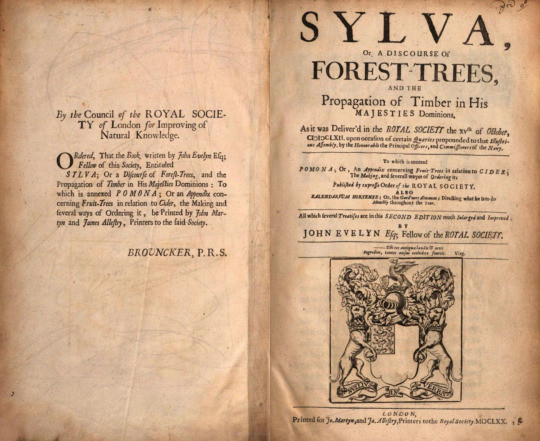
4 notes
·
View notes
Photo

Untitled (Lady Filmer seated in center, to her right, Miss Murray, standing behind Lady Filmer, Lady Alfred Murray, seated to Lady Filmer's left, Lord Tyrone), Mary Georgiana Caroline Cecil Filmer, 1862-1888, Harvard Art Museums: Photographs
Sitter information: Miss Murray Lady Filmer (1838-1903) Lady Alfred Murray Lord Tyrone. John Henry De La Poer (Beresford). Born 21 May 1844, died, by his own hand, 23 October 1895. Styled Earl of Tyrone 1859-1866. KP. MP for Waterford 1865-... Harvard Art Museums/Fogg Museum, Purchase through the generosity of Melvin R. Seiden Size: 28.9 x 23.2 cm (11 3/8 x 9 1/8 in.) Medium: Album page albumen silver print, decorated with red and gilt paint in the four corners of the page. Clockwise from upper left corner, "M" with Bessie written inside; upper right "M" with Agnes written inside; lower right "T" decorated with red striped ribbon tied in a bow; lower left, T with "Marie" written on a banner crossing the "T".
https://www.harvardartmuseums.org/collections/object/317520
2 notes
·
View notes
Photo


British Presentation Sword to an English Officer Serving in Portugal, 1810
With curved fullered blade double-edged towards the point and etched on one side with the recipient's name, 'Roberto Joanni Harvey', and 'Beneficiorum Memores Septembro 1810' in Latin beneath, and along one side with a list of those persons who contributed to the presentation, the hilt comprising ebony grip with gilt foliate grip studs, gilt cross-guard cast and chased with a crescent and acanthus leaves on each side, and quillons with bud-shaped terminals, in its re-leathered scabbard with gilt mounts, the scrolling borders engraved with foliate scrolls and chased with bands of leaves, and with fixed rings for suspension. 76 cm blade.
Robert John Harvey was commissioned into the 53rd Foot in 1803 and moved to Portugal in 1809. In June 1809 he was appointed Deputy Assistant Quartermaster General attached to Lord Beresford. Harvey's task appears to have been recruiting and training guerilla fighters and he was involved in more than one daring raid on French supply trains and it is his colleagues from this period who presented him with the sword. In August 1810 Harvey rejoined his regiment and was present at most of the major Peninsular engagements, receiving an Army gold medal for the battle of Orthes and later a nine bar Military General Service medal. He attained the rank of Lieutenant Colonel in June 1813 and by the end of the campaign was on Wellington's staff in Paris. He was knighted in 1817, became Colonel of the 2nd West India Regiment in 1830 and attained the rank of General in 1859, a year before his death.
83 notes
·
View notes
Photo

Mrs. William Beresford and her Son John, later Lord Decies by Joshua Reynolds (1775)
#mrs william beresford#lord decies#joshua reynolds#1770s#1775#art#portrait#painting#family portrait#british#european#children
4 notes
·
View notes